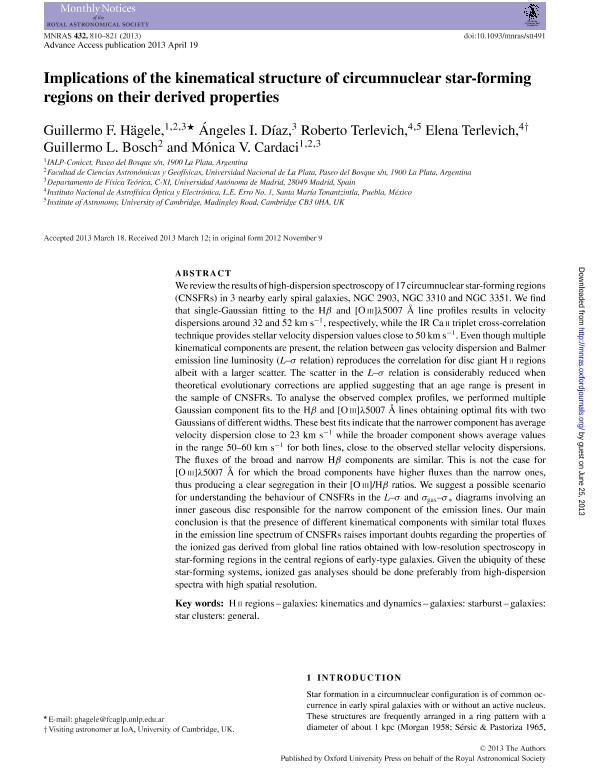Mostrar el registro sencillo del ítem
dc.contributor.author
Hägele, Guillermo Federico

dc.contributor.author
Díaz, Angeles
dc.contributor.author
Terlevich, Roberto
dc.contributor.author
Terlevich, Elena
dc.contributor.author
Bosch, Guillermo Luis

dc.contributor.author
Cardaci, Monica Viviana

dc.date.available
2017-01-09T13:41:24Z
dc.date.issued
2013-05
dc.identifier.citation
Hägele, Guillermo Federico; Díaz, Angeles; Terlevich, Roberto; Terlevich, Elena; Bosch, Guillermo Luis; et al.; Implications of the kinematical structure of circumnuclear star-forming regions on their derived properties; Oxford University Press; Monthly Notices Of The Royal Astronomical Society; 432; 1; 5-2013; 810-821
dc.identifier.issn
0035-8711
dc.identifier.uri
http://hdl.handle.net/11336/10966
dc.description.abstract
We review the results of high dispersion spectroscopy of 17 circumnuclear star forming regions (CNSFRs) in 3 nearby early spiral galaxies, NGC 2903, NGC 3310 and NGC 3351.We find that single Gaussian fitting to the Hβ and [Oiii]λ5007 ˚A line profiles results in velocity dispersions around 32 km s−1 and 52 km s−1, respectively, while the IR Caii triplet cross-correlation technique provides stellar velocity dispersion values close to 50 km s−1. Even though multiple kinematical components are present, the relation between gas velocity dispersion and Balmer emission line luminosity (L-σ relation) reproduces the correlation for disk giant Hii regions albeit with a larger scatter. The scatter in the L-σ relation is considerably reduced when theoretical evolutionary corrections are applied suggesting that an age range is present in the sample of CNSFRs. To analyse the observed complex profiles, we performed multiple Gaussian component fits to the Hβ and [Oiii]λ5007 ˚A lines obtaining optimal fits with two Gaussians of different width. These best fits indicate that the narrower component has average velocity dispersion close to 23 km s−1 while the broader component shows average values in the range 50-60 km s−1 for both lines, close to the observed stellar velocity dispersions. The fluxes of the broad and narrow Hβ components are similar. This is not the case for [Oiii]λ5007 ˚A for which the broad components have higher fluxes than the narrow ones, thus producing a clear segregation in their [Oiii]/Hβ ratios. We suggest a possible scenario for understanding the behaviour of CNSFRs in the L-σ and σgas-σ∗ diagrams involving an inner gaseous disk responsible for the narrow component of the emission lines. Our main conclusion is that the presence of different kinematical components with similar total fluxes in the emission line spectrum of CNSFRs raises important doubts regarding properties of the ionized gas derived from global line ratios obtained with low resolution spectroscopy in star-forming regions in the central regions of early type galaxies. Given the ubiquity of these star-forming systems, ionized gas analyses should be done preferably from high dispersion spectra with high spatial resolution.
dc.format
application/pdf
dc.language.iso
eng
dc.publisher
Oxford University Press

dc.rights
info:eu-repo/semantics/openAccess
dc.rights.uri
https://creativecommons.org/licenses/by-nc-sa/2.5/ar/
dc.subject
Hii Regions
dc.subject
Kinematics (Galaxias)
dc.subject
Starbursts
dc.subject
Star Clusters
dc.subject
Dynamics (Galaxias)
dc.subject.classification
Astronomía

dc.subject.classification
Ciencias Físicas

dc.subject.classification
CIENCIAS NATURALES Y EXACTAS

dc.title
Implications of the kinematical structure of circumnuclear star-forming regions on their derived properties
dc.type
info:eu-repo/semantics/article
dc.type
info:ar-repo/semantics/artículo
dc.type
info:eu-repo/semantics/publishedVersion
dc.date.updated
2016-11-18T15:11:04Z
dc.journal.volume
432
dc.journal.number
1
dc.journal.pagination
810-821
dc.journal.pais
Reino Unido

dc.journal.ciudad
Londres
dc.description.fil
Fil: Hägele, Guillermo Federico. Consejo Nacional de Investigaciones Científicas y Técnicas. Centro Científico Tecnológico la Plata. Instituto de Astrofísica de la Plata; Argentina. Universidad Nacional de la Plata. Facultad de Ciencias Astronómicas y Geofísicas; Argentina. Universidad Autónoma de Madrid; España
dc.description.fil
Fil: Díaz, Angeles. Universidad Autónoma de Madrid. Facultad de Ciencias; España
dc.description.fil
Fil: Terlevich, Roberto. Instituto Nacional de Astronomía, Óptica y Electrónica; México. University of Cambridge; Reino Unido
dc.description.fil
Fil: Terlevich, Elena. Instituto Nacional de Astronomía, Óptica y Electrónica; México
dc.description.fil
Fil: Bosch, Guillermo Luis. Consejo Nacional de Investigaciones Científicas y Técnicas. Centro Científico Tecnológico la Plata. Instituto de Astrofísica de la Plata; Argentina. Universidad Nacional de la Plata. Facultad de Ciencias Astronómicas y Geofísicas; Argentina
dc.description.fil
Fil: Cardaci, Monica Viviana. Consejo Nacional de Investigaciones Científicas y Técnicas. Centro Científico Tecnológico la Plata. Instituto de Astrofísica de la Plata; Argentina. Universidad Nacional de la Plata. Facultad de Ciencias Astronómicas y Geofísicas; Argentina. Universidad Autónoma de Madrid; España
dc.journal.title
Monthly Notices Of The Royal Astronomical Society

dc.relation.alternativeid
info:eu-repo/semantics/altIdentifier/doi/http://dx.doi.org/10.1093/mnras/stt491
dc.relation.alternativeid
info:eu-repo/semantics/altIdentifier/url/http://mnras.oxfordjournals.org/content/432/1/810
Archivos asociados
